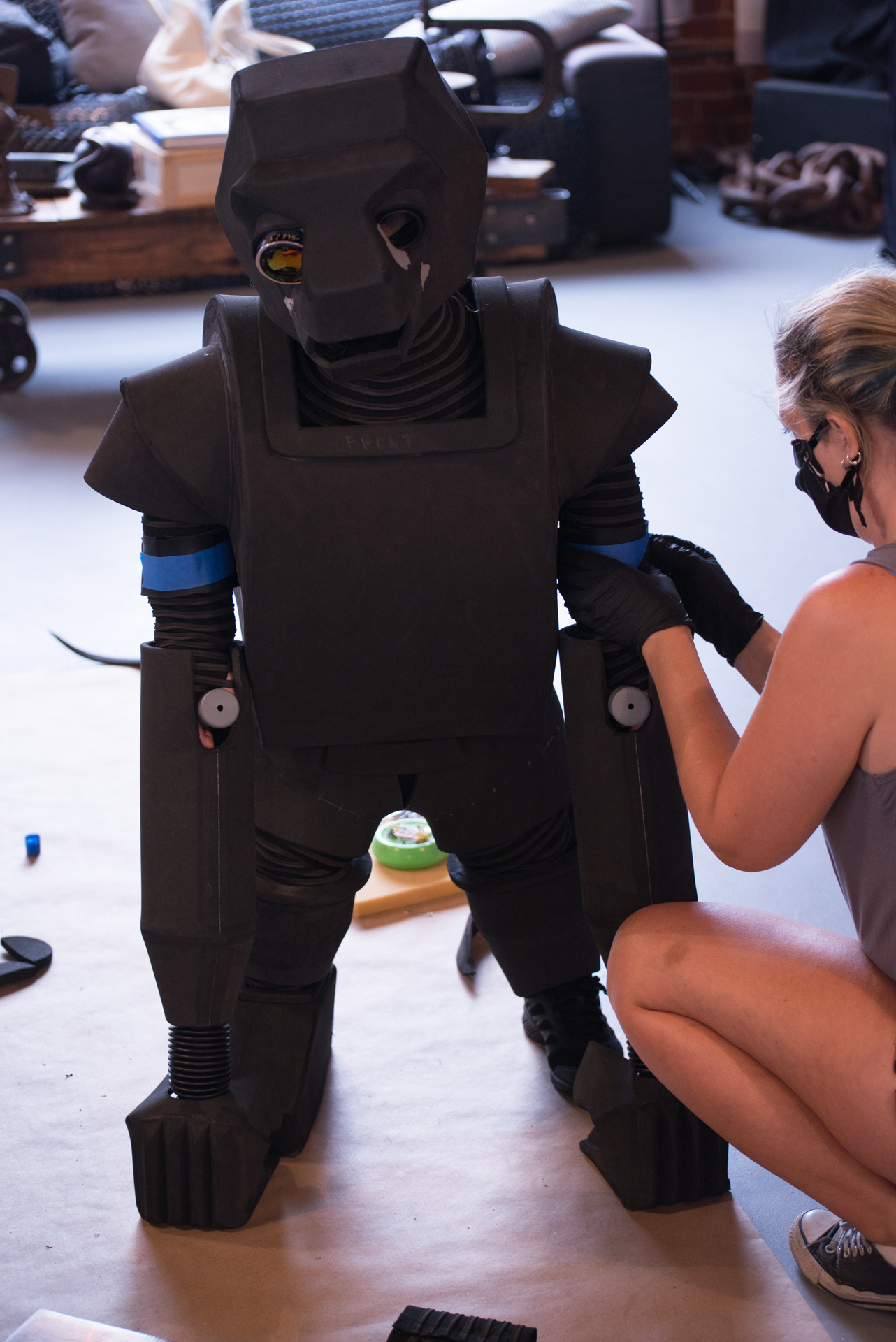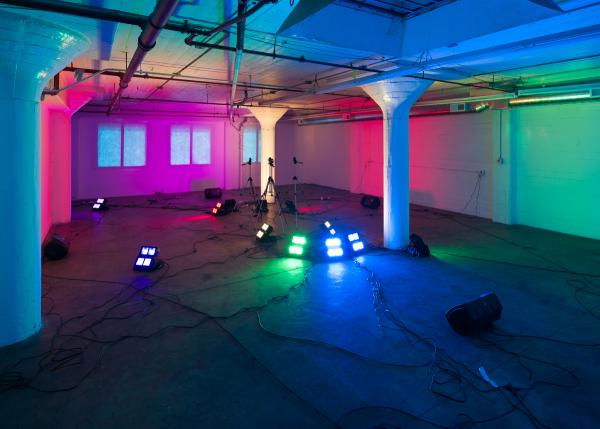Artmaking is challenging. Like technological innovation, the process of artistic production is often far from linear and paved with failure. Sometimes an artist project fails because there is not enough budget, sometimes it's a technical limitation, sometimes there's not enough time, and sometimes it's just not meant to be.
Failure has a long history with LACMA's art and technology endeavors over the past fifty-odd years. More than half of the projects in its original initiative (1967–1971) showed no results. Collaborators stopped speaking to each other, artists walked off the project, technology partners balked at supporting creative ventures that lacked a specific outcome. This was to be expected given the program's highly experimental nature. Maurice Tuchman, LACMA curator and director of the original Art & Technology program wrote in the 1971 exhibition catalogue:
I thought that it would be fascinating to observe a potentially vital reciprocal process, and expected personal and professional gratification from my role as catalyst in establishing the vehicle for such connections. I believed that it was the process of interchange between artist and company that was most significant, rather than whatever tangible results might quickly occur.... I did not regard the "success" or failure of the project as resting mainly with the quantity or even quality of the "results."
Inspired by LACMA's original Art & Technology program, the museum's current Art + Technology Lab strives to provide the same failure-tolerant environment for artists to experiment with new technologies and take purposeful risks. One of the artists to venture into this space via our program is world-renowned artist Diana Thater.
Thater applied to the Art + Technology Lab program to develop a new body of work focused on bio-inspired and bio-mimetic robots. Working in video, she sought to investigate how these machines adapt the neurophysiology and behavior of their animal models. She began her work shortly after she was awarded her grant in the summer of 2018. Searching for a muse, she initially set her sights on the Massachusetts Institute of Technology's (MIT) cheetah robot, but the MIT Biomimetics Robotics Lab could not be reached after multiple attempts at contact. Thater was also interested in a number of defense industry robots made by Boston Dynamics, which turned out to be a non-starter as its machines' malevolent appearances contrasted from the animal-like qualities she was looking for.
When neither Boston Dynamics nor MIT panned out, Thater met with an engineer at the aerospace manufacturer and space transportation services company SpaceX to discuss potential options. Although his current duties were focused on propulsion, his reputable academic background in robotics was promising. Shortly after talking with Thater, he introduced the artist to Dr. Dennis Hong, a roboticist at UCLA who made robotic spiders, snakes, and humanoids. Unfortunately, these options lacked the desired resonance; after visiting Dr. Hong's lab, Thater still had not found a robotic muse that could serve as an inspiration.
Finally, Thater found what she was looking for when she was introduced to JPL's Robosimian—a robot based on an orangutan. After a few conversations with engineers from JPL Robotics, she planned to film Robosimian's locomotion testing in Death Valley, a stunning backdrop for her subject. The artist assembled a film crew and equipment and was set to film in January of 2019. Then a government shutdown occurred, closing the National Park and generating costly delays for the tests and film shoot, which did not occur until March of 2019.
When it did happen, the shoot went according to plan. Thater shot Robosimian from two and then four angles simultaneously. The rugged backdrop of the Mojave Desert with the mountains in the background was breathtaking. Juxtaposed against this scenery, the robot's slow and deliberate movements were not compelling. Although quite competent, Robosimian was not lifelike enough.
Again, Thater went back to the drawing board, this time rethinking her ideas in terms of computer graphics or "CG." Working in this vein, she would have the freedom to design the robot that she envisioned, and capture it moving and gesturing in the exact way she desired. Then the bids for the work came in at sums that rivaled the project's entire budget many times over. Quickly, it became apparent that budget constraints would prevent the artist from further pursuing this route. Undaunted, Thater looked for more affordable alternatives. Talking to an entertainment designer, she came upon the idea of making her robot a "practical effect," or a special effect that is produced physically, not digitally. This was the simplest and most affordable option, and soon she was working with an entertainment designer and costume builder (Michael Schmidt Studios in Hollywood) to create a robot costume. The robot was based on a 4-foot-tall chimpanzee. Thater hired a professional actor to play the role. After testing the concept, the result was stranger than what she had found with the previous approaches. The practical effect added a cartoon-like quality and was slightly alienating and strange. Things were starting to come together again and the artist began to consider another film shoot.

Thater abandoned the idea of shooting in Death Valley again and instead opted for Green Animals Topiary Garden in Newport, Rhode Island. Over 100 years old, it is filled with hedges shaped as elephants, giraffes, and dolphins, and appeared in Errol Morris's 1997 film Fast, Cheap, and Out of Control. As Thater describes the Garden, it is a "relic of the past, a romantic representation of our relationship to the animal… a fossilized royal menagerie full of exotic things." In the video, the robot was to walk around the Garden observing the animal topiaries. It would be shot from multiple angles, in Super-8, 16mm, and 4K video. Besides for a moment at the end of the piece, when the crew is meant to be visible on one screen, it would be filmed without humans—a place where an imitation of an animal (a chimp—one of the most intelligent animals) would contemplate other imitations of animals. After visiting the Garden in the fall of 2019 for some tests, the shoot was scheduled to take place in the late summer of 2020 when the Garden would be healthy and verdant. The footage would then be edited and the video was to debut in a solo exhibition at David Zwirner in New York in the fall of 2020.
By March of 2020, COVID-19 reached the United States and was soon given pandemic status. Based in California, Thater, her actor, and crew grew increasingly hesitant to fly across the country in the midst of a massive outbreak. The health statistics continued to rise and by late spring it was apparent that the shoot would be canceled. Shortly thereafter, it was determined that the exhibition at Zwirner was to have a virtual format instead of taking place in a physical space. The indefatigable Thater pivoted once again, starting from scratch this time and drawing upon her interest in animals and the common experience of isolation so prevalent across the country and throughout the world. Eschewing biomimetics, this new work was inspired by a Bertolt Brecht poem and a whale who sings at a frequency seemingly incomprehensible to his peers. Named simply "Whale 52," he sings into the darkness, never receiving a response, but continuing nonetheless. The work is an installation that engages light and sound and is experienced as a multi-channel livestream. It is called Yes, there will be singing.
This is the only way Thater's project could end. For an artist venture that persevered in the face of innumerable challenges, an artwork that speaks to persistence (however absurd) and reaching out into the unknown, makes a perfect coda. In the words of Thater, "The installation meditates on the voice in space, its unanswered call, and the necessity of communication and interrelation—even, or especially, when physical proximity is precluded."
Diana Thater's virtual exhibition, Yes, there will be singing, is on view until November 28, 2020. Learn more!
Diana Thater has several works in LACMA's collection and was the subject of the major exhibition Diana Thater: The Sympathetic Imagination (November 22, 2015–April 17, 2016). This exhibition was presented by Hyundai Motor Company as part of The Hyundai Project at LACMA.
The Art + Technology Lab is presented by
The Art + Technology Lab is made possible by YouTube Learning, and Snap Inc.
Additional support is provided by SpaceX.
The Lab is part of The Hyundai Project: Art + Technology at LACMA, a joint initiative exploring the convergence of art and technology.
Seed funding for the development of the Art + Technology Lab was provided by the Los Angeles County Quality and Productivity Commission through the Productivity Investment Fund and LACMA Trustee David Bohnett.





